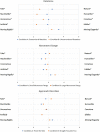Human-Like Movements of Industrial Robots Positively Impact Observer Perception
- PMID: 36570426
- PMCID: PMC9763088
- DOI: 10.1007/s12369-022-00954-2
Human-Like Movements of Industrial Robots Positively Impact Observer Perception
Abstract
The number of industrial robots and collaborative robots on manufacturing shopfloors has been rapidly increasing over the past decades. However, research on industrial robot perception and attributions toward them is scarce as related work has predominantly explored the effect of robot appearance, movement patterns, or human-likeness of humanoid robots. The current research specifically examines attributions and perceptions of industrial robots-specifically, articulated collaborative robots-and how the type of movements of such robots impact human perception and preference. We developed and empirically tested a novel model of robot movement behavior and demonstrate how altering the movement behavior of a robotic arm leads to differing attributions of the robot's human-likeness. These findings have important implications for emerging research on the impact of robot movement on worker perception, preferences, and behavior in industrial settings.
Keywords: Acceptance; Anthropomorphism; Articulated robot; Collaborative robots; HRI; Human-likeness; Industrial robots; Movements.
© The Author(s), under exclusive licence to Springer Nature B.V. 2022, Springer Nature or its licensor (e.g. a society or other partner) holds exclusive rights to this article under a publishing agreement with the author(s) or other rightsholder(s); author self-archiving of the accepted manuscript version of this article is solely governed by the terms of such publishing agreement and applicable law.
Figures



References
-
- IFR: Executive Summary WR 2021—Service Robots (2021). https://ifr.org/img/worldrobotics/Executive_Summary_WR_Service_Robots_20...
-
- IFR: Executive Summary WR 2021 Industrial Robots (2021). https://ifr.org/img/worldrobotics/Executive_Summary_WR_Industrial_Robots...
-
- Eimontaite I, Jaksic C, Fletcher S, Johnson T, Oostveen A-M. Will operators work in close proximity to industrial robots? A study of acceptance using psychological and physiological responses. SSRN Electronic Journal. 2020 doi: 10.2139/ssrn.3718020. - DOI
-
- Weiss A, Wortmeier AK, Kubicek B. Cobots in Industry 4.0: a roadmap for future practice studies on human–robot collaboration. IEEE Transactions on Human-Machine Systems. 2021 doi: 10.1109/THMS.2021.3092684. - DOI
-
- Lotz V, Himmel S, Ziefle M (2019) You’re my mate-acceptance factors for human–robot collaboration in industry. In: International conference on competitive manufacturing. Stellenbosch, South Africa (February)
LinkOut - more resources
Full Text Sources
Miscellaneous
